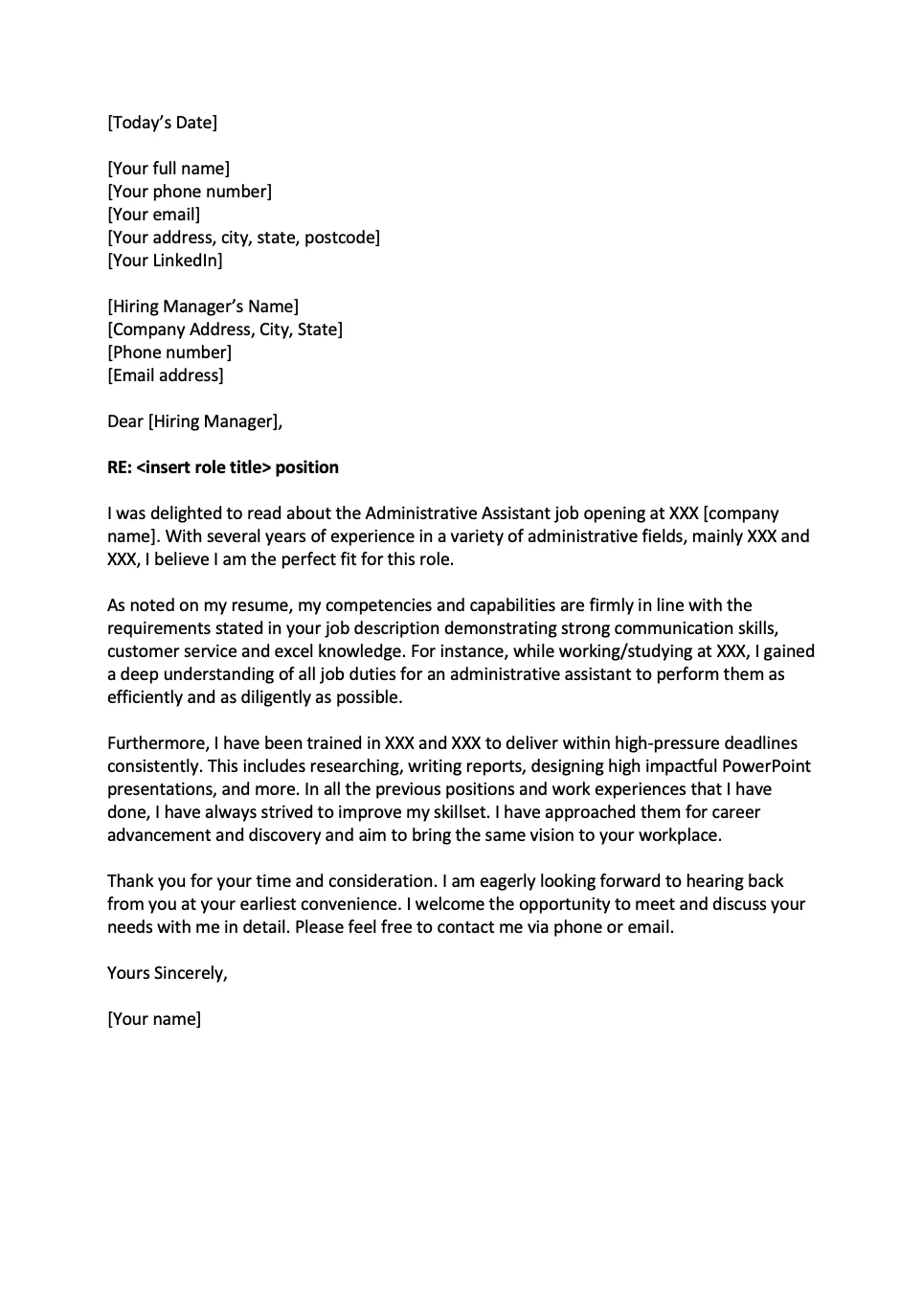Why a Great Admin Cover Letter Matters
In the competitive world of administrative positions, a compelling cover letter can be your golden ticket to securing an interview. It’s often the first point of contact you have with a potential employer and a critical opportunity to make a strong first impression. A well-crafted cover letter demonstrates your professionalism, communication skills, and genuine interest in the role. It provides a platform to showcase your relevant skills and experience, going beyond the basic details in your resume. It’s your chance to highlight why you are the perfect fit for the specific administrative position, setting you apart from other applicants. A well-written cover letter shows you have taken the time and effort to understand the role and the company, indicating a proactive and thoughtful approach to your job search. Neglecting this crucial document can mean missing out on opportunities and falling behind other candidates. Therefore, taking the time to write a standout cover letter is an investment in your career, showing the potential employer that you are serious about the position.
Key Components of an Impressive Cover Letter
An impressive administrative cover letter is more than just a formality; it is a strategic marketing tool. It needs to capture the hiring manager’s attention immediately and maintain their interest throughout. This involves structuring the letter in a way that highlights your skills, experience, and enthusiasm. The key components, from formatting to the content within each section, must be carefully considered. The goal is to present yourself as the best candidate for the job by demonstrating your understanding of the role and how you can contribute to the company’s success. Ensure that you showcase your qualifications with precision, and tailor the letter to each specific application. This customized approach, combined with a professional tone, will significantly improve your chances of being invited for an interview. Focus on clarity and directness, ensuring that your cover letter is easy to read and understand, allowing the hiring manager to quickly grasp your value proposition. Presenting a well-structured and insightful cover letter shows you possess excellent communication skills.
Formatting Your Cover Letter for Maximum Impact
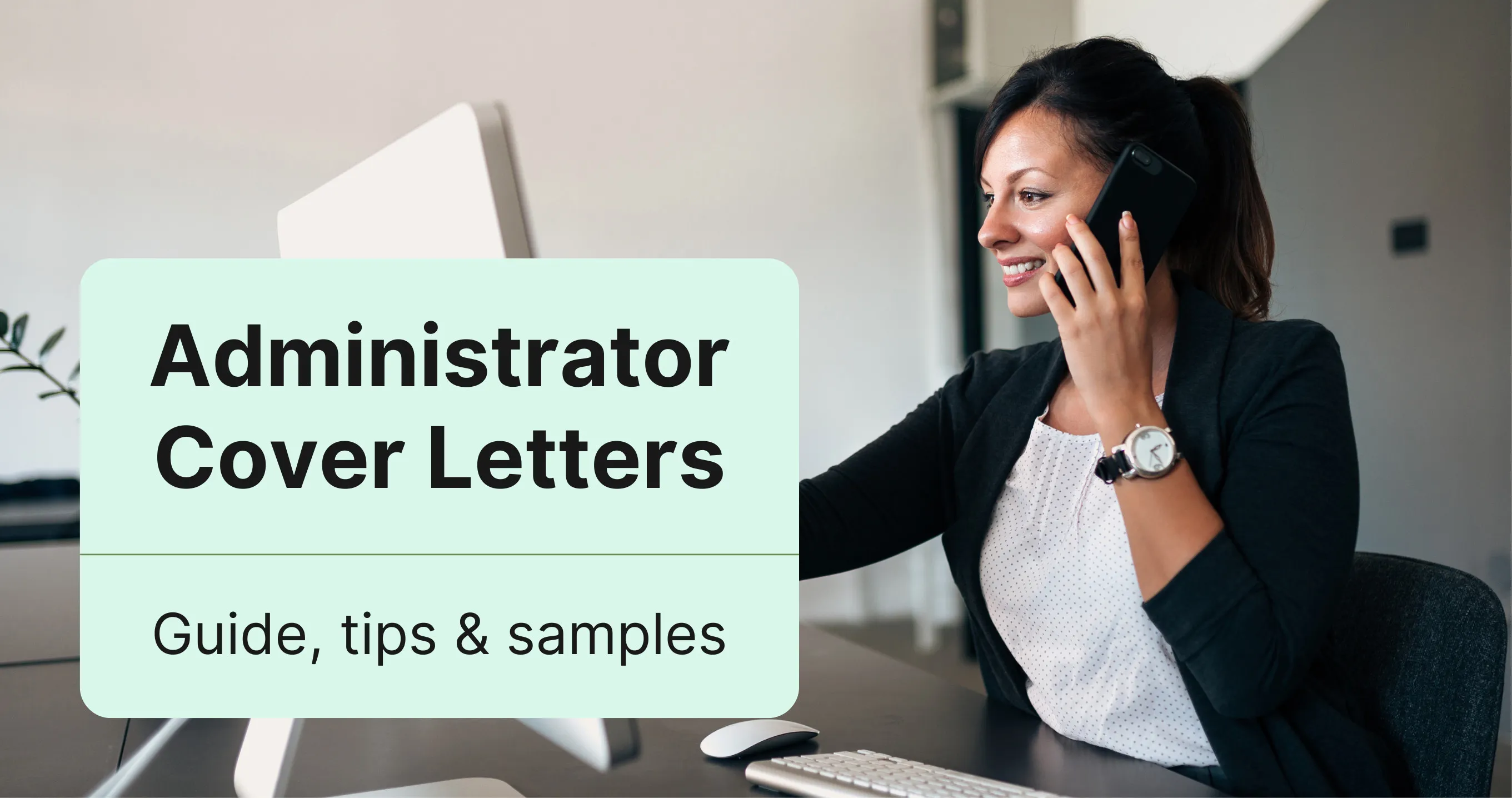
The appearance of your cover letter is just as important as its content. Proper formatting ensures that your letter is easy to read and professional-looking. Choose a clean, readable font like Arial or Times New Roman, and maintain a consistent font size (11 or 12 points). Use single spacing for the body of the letter and double spacing between paragraphs. This creates visual breaks that make the text more digestible. Keep your margins at one inch on all sides to provide sufficient white space, making your letter less cluttered. Limit your cover letter to one page; brevity is key to holding the hiring manager’s attention. Use clear headings to organize your content and guide the reader through the essential parts of your application. Well-formatted cover letter presents you as organized and detail-oriented, which are essential qualities for administrative roles. This attention to detail demonstrates that you take pride in your work and respect the hiring manager’s time. Always proofread your cover letter meticulously to catch any formatting errors before submitting. Remember that your letter is a reflection of your attention to detail, so making sure its visually appealing can increase your chances.
Essential Cover Letter Sections
Every effective administrative cover letter must include several key sections that work together to present you in the best possible light. These sections, when carefully crafted, guide the reader from the initial greeting to the closing, highlighting your suitability for the role. Each section plays a crucial role in building your case and making a lasting impression. From providing contact information and a clear greeting, to showcasing your skills and expressing enthusiasm, each element contributes to the overall impact of your cover letter. By understanding the purpose of each section, you can structure your letter to maximize its effectiveness and enhance your chances of securing an interview. A well-organized structure demonstrates professionalism, communication skills, and attention to detail - all vital qualities for an administrative position. These sections are like building blocks that together build a case for why you are the best candidate.
Header Contact Information and Date
The header of your administrative cover letter sets the stage and provides the essential contact details. Begin with your full name, address, phone number, and professional email address. Ensure your email address is professional (e.g., jane.doe@email.com) and not a casual or outdated one. Following your contact information, include the date. This allows the hiring manager to see when the letter was written and helps in the organization of your application. Proper formatting and accuracy in this section show your attention to detail, which is a crucial attribute for administrative roles. This information ensures the hiring manager can easily contact you and helps to give your application a polished appearance from the very start. Make sure all information is up-to-date and correct to avoid any communication issues and show you are a person that can be trusted.
Salutation Addressing the Hiring Manager
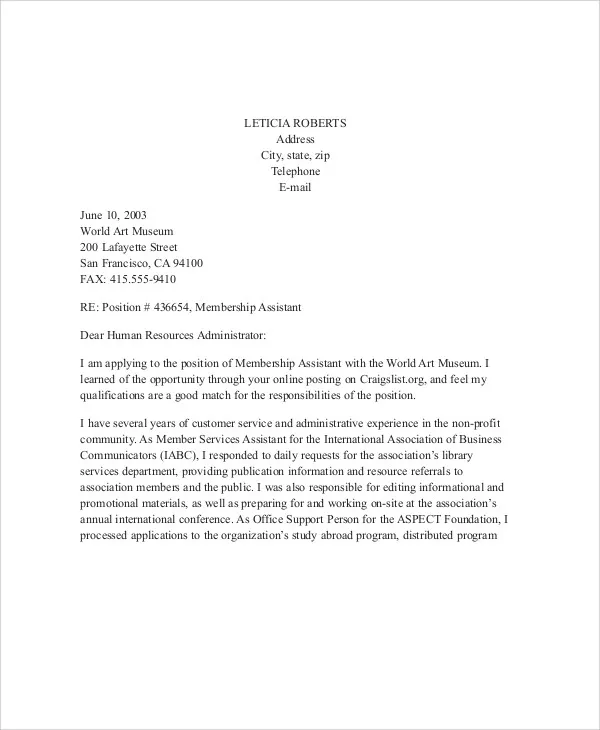
The salutation is your opportunity to create a positive first impression and establish a professional tone. Aim to address the hiring manager by name, if possible. Research the company and the specific role to find the name of the hiring manager. If you cannot find a specific name, use a general greeting such as “Dear Hiring Manager” or “Dear [Company Name] Team”. Avoid generic greetings like “To Whom It May Concern” as these can appear impersonal. A personalized greeting shows you have taken the time to research the company and demonstrates your attention to detail and willingness to go the extra mile. Ensuring the correct spelling of the recipient’s name is essential; it indicates respect and attention to detail. The salutation sets the tone for the rest of your cover letter and reflects your level of professionalism. In this regard, it is highly recommended to spend some time to get the correct name of the recipient, instead of taking the easy way out.
The Opening Paragraph Grabbing Their Attention
The opening paragraph is your chance to grab the reader’s attention immediately. Start with a strong statement that clearly states the position you are applying for and how you learned about it. Briefly mention your key skills or experiences that make you an ideal candidate. Avoid generic opening lines. Instead, show your enthusiasm for the role and the company. You can highlight a specific achievement or a unique qualification that aligns with the job requirements. The goal is to make the hiring manager want to read more. Demonstrate your understanding of the company’s values or mission, and explain why you are excited about the opportunity. Your opening paragraph sets the tone for the rest of the cover letter, so make it count. This demonstrates your ability to communicate effectively and persuasively, which is crucial for any administrative position, making sure to highlight your strong points immediately.
Highlighting Your Skills and Experience
The body of your cover letter is where you showcase your relevant skills and experience. Tailor your content to align with the specific requirements listed in the job description. This section provides a detailed view of what you can offer, going beyond the information included in your resume. Provide specific examples of your accomplishments. Use the STAR method (Situation, Task, Action, Result) to describe your experiences and demonstrate how you successfully handled situations in the past. Quantify your achievements whenever possible, using numbers and data to show the impact of your work. This allows the hiring manager to easily understand your value. Maintain a professional tone while showcasing your personality. This section should prove that you have not only the skills but also the experience necessary to excel in the administrative role, making a strong case for your candidacy, making sure you demonstrate how you can perform the responsibilities of the position.
Administrative Skills to Showcase
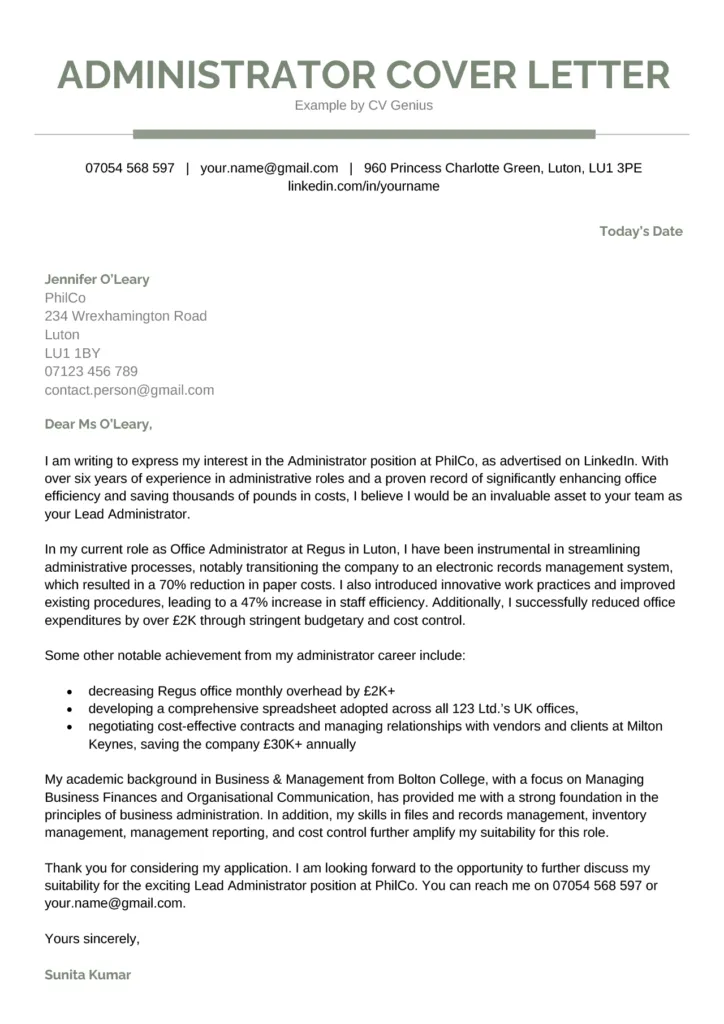
When applying for an administrative position, it’s vital to highlight skills that directly relate to the job requirements. These skills often include excellent organizational abilities, strong communication, proficiency in relevant software (like Microsoft Office Suite), and attention to detail. Mention your ability to manage calendars, schedule meetings, and handle correspondence efficiently. Demonstrate your problem-solving skills and your ability to work both independently and as part of a team. Highlight your experience with data entry, record keeping, and managing office supplies. If the job description mentions specific software, be sure to include those skills. Showing competence in these areas tells the employer that you are prepared and capable of fulfilling the role’s responsibilities. Customizing the skills you mention based on the job description ensures relevance and illustrates that you understand the position’s needs. Also include your skills in using office equipment and managing electronic files. Be sure to include all of your relevant skills.
Experience in Admin Roles Quantify Your Success
Provide specific examples of your past administrative experiences. Focus on accomplishments rather than simply listing responsibilities. Use action verbs to describe your duties, such as “managed,” “coordinated,” or “implemented.” Whenever possible, quantify your successes using numbers and data. For example, instead of saying “improved office efficiency,” write “improved office efficiency by 15% by implementing a new filing system.” Show the impact of your work, highlighting the benefits your actions brought to previous employers. If you have experience training new employees, mention it. This illustrates your leadership skills and willingness to share knowledge. Quantifying your accomplishments makes your cover letter more impactful and demonstrates your capabilities, enhancing your credibility and showcasing the value you bring to a potential employer. This helps the hiring manager understand your impact on previous companies and consider your potential contribution, showing your ability to be a good investment for the company.
Tailoring Your Cover Letter
Tailoring your cover letter to each job application is an important step. Generic cover letters are often discarded, as they suggest a lack of interest and attention to detail. Carefully review the job description and identify the key skills and qualifications the employer is seeking. Then, customize your letter to match those requirements. Highlight the experiences, skills, and achievements that are most relevant to the position. Research the company, their culture, and values, and mention how your experience aligns with their goals. This shows that you’ve taken the time to learn about the organization and understand the role. When you tailor your letter, you signal that you understand the specific needs of the company. This level of customization demonstrates a proactive approach and enhances your chances of securing an interview. Tailoring your cover letter shows you are invested in the role and it is not just a generic job application.
Show, Don’t Tell Providing Examples
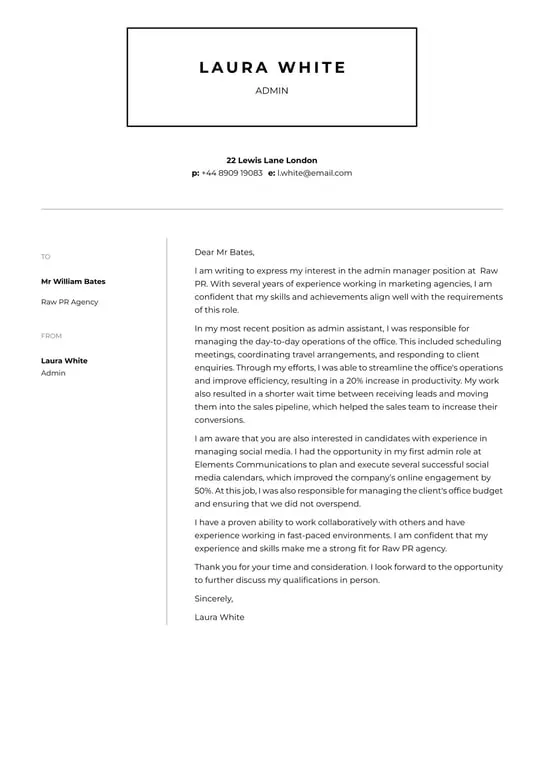
Instead of simply listing your skills, show the hiring manager how you’ve used them. Provide concrete examples of your achievements. Use the STAR method (Situation, Task, Action, Result) to structure your examples. Briefly describe the situation, the task you were assigned, the actions you took, and the results you achieved. For instance, if you are highlighting your organizational skills, you might describe a time when you successfully managed a large project, outlining the steps you took and the positive outcome. Provide specific details to illustrate your point. This approach provides the hiring manager with tangible proof of your capabilities, making your claims more believable and impactful. Offering practical examples shows that you not only possess the skills but can also apply them effectively in a real-world setting, proving you can deliver tangible value. Giving examples demonstrates your capabilities far better than just listing the skills without any proof.
Closing Your Cover Letter and Call to Action
The closing of your cover letter is where you re-emphasize your interest and make a call to action. Thank the hiring manager for their time and consideration. Reiterate your enthusiasm for the position, and mention why you believe you are a good fit for the role and the company. State your availability for an interview, and include the best way to reach you. Avoid clichés and generic phrases. A strong closing paragraph reaffirms your interest, reinforces your qualifications, and encourages the hiring manager to take the next step. This leaves a lasting positive impression and increases your chances of being invited for an interview. Ensure that your call to action is clear, concise, and professional, demonstrating your eagerness to advance in the hiring process. Your closing paragraph should emphasize your interest in the role and how you can contribute to the company.
Expressing Enthusiasm and Availability
Expressing enthusiasm for the position and the company is crucial in your closing. Show that you are genuinely interested in the opportunity and excited about the prospect of joining their team. Mention what specifically attracts you to the company or the role, such as their values, mission, or the nature of the work. Clearly state your availability for an interview. Provide your preferred contact information and express your willingness to discuss your qualifications further. This demonstrates your proactive approach and allows the hiring manager to easily take the next step. Avoid a passive closing. Be direct and confident in your interest in the position. A confident and enthusiastic closing reinforces your candidacy and encourages the hiring manager to see you as a suitable candidate. Expressing your enthusiasm helps the reader to feel that you are truly invested in the position.
Proofreading and Final Touches
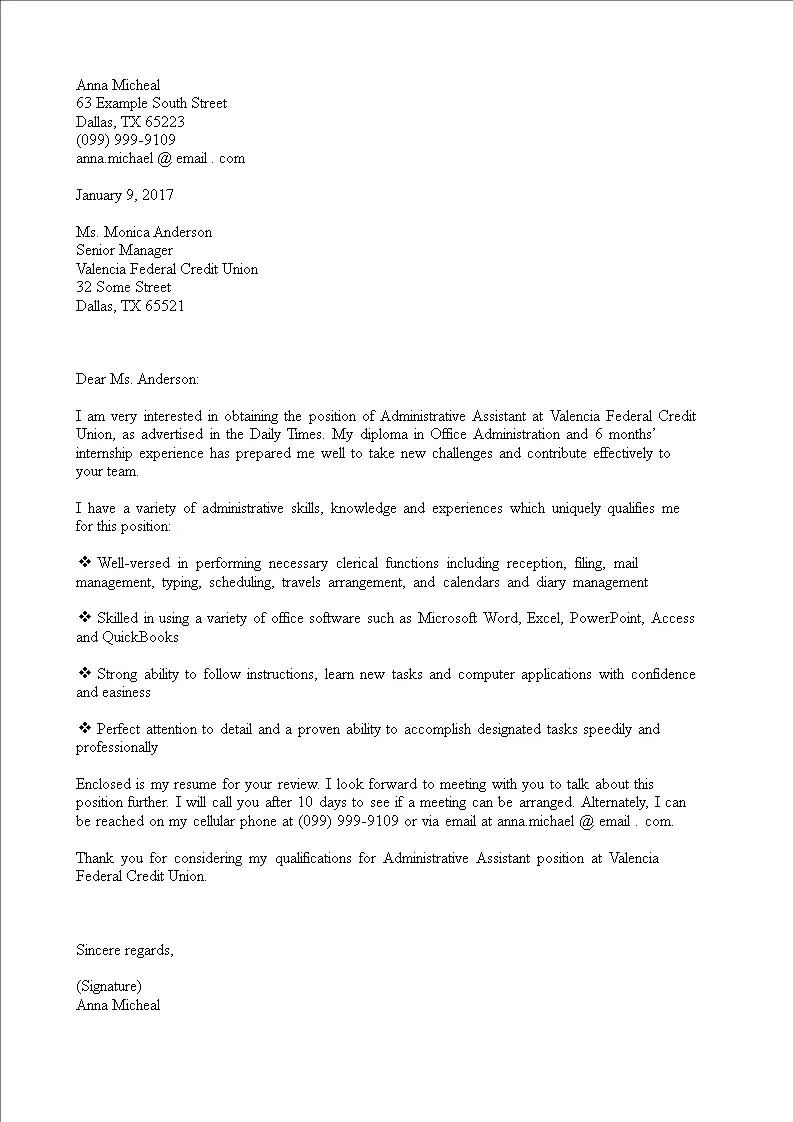
Before submitting your cover letter, proofread it meticulously. Errors in grammar, spelling, and punctuation can damage your credibility. Check for any typos or formatting inconsistencies. Read your letter aloud to catch awkward phrasing or sentences that don’t flow smoothly. Ask a friend or family member to review it as well; a fresh pair of eyes can often spot errors that you might miss. Make sure your contact information is correct and up-to-date. Ensure that your letter is tailored to the specific job description and that all requirements are met. Double-check that the formatting is consistent throughout. The final touches demonstrate your attention to detail and professionalism, which are essential qualities for an administrative position. Taking these final steps ensures that your cover letter presents you in the best possible light and increases your chances of getting an interview, showing the employer you pay attention to detail.
